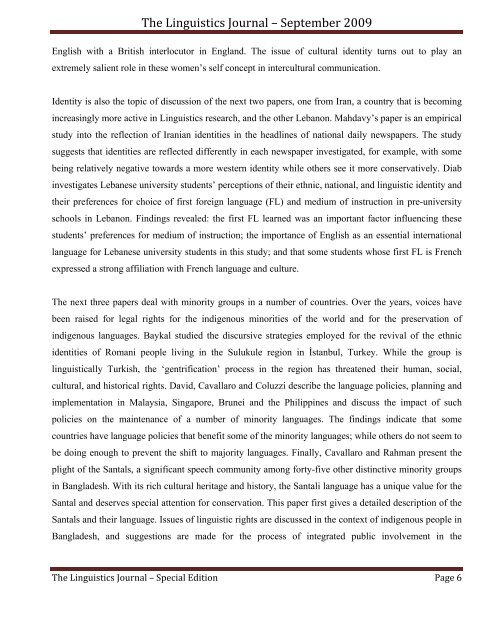The Linguistics Journal September 2009 Special Edition Language
The Linguistics Journal September 2009 Special Edition Language
The Linguistics Journal September 2009 Special Edition Language
You also want an ePaper? Increase the reach of your titles
YUMPU automatically turns print PDFs into web optimized ePapers that Google loves.
<strong>The</strong> <strong>Linguistics</strong> <strong>Journal</strong> – <strong>September</strong> <strong>2009</strong><br />
English with a British interlocutor in England. <strong>The</strong> issue of cultural identity turns out to play an<br />
extremely salient role in these women’s self concept in intercultural communication.<br />
Identity is also the topic of discussion of the next two papers, one from Iran, a country that is becoming<br />
increasingly more active in <strong>Linguistics</strong> research, and the other Lebanon. Mahdavy’s paper is an empirical<br />
study into the reflection of Iranian identities in the headlines of national daily newspapers. <strong>The</strong> study<br />
suggests that identities are reflected differently in each newspaper investigated, for example, with some<br />
being relatively negative towards a more western identity while others see it more conservatively. Diab<br />
investigates Lebanese university students’ perceptions of their ethnic, national, and linguistic identity and<br />
their preferences for choice of first foreign language (FL) and medium of instruction in pre-university<br />
schools in Lebanon. Findings revealed: the first FL learned was an important factor influencing these<br />
students’ preferences for medium of instruction; the importance of English as an essential international<br />
language for Lebanese university students in this study; and that some students whose first FL is French<br />
expressed a strong affiliation with French language and culture.<br />
<strong>The</strong> next three papers deal with minority groups in a number of countries. Over the years, voices have<br />
been raised for legal rights for the indigenous minorities of the world and for the preservation of<br />
indigenous languages. Baykal studied the discursive strategies employed for the revival of the ethnic<br />
identities of Romani people living in the Sulukule region in İstanbul, Turkey. While the group is<br />
linguistically Turkish, the ‘gentrification’ process in the region has threatened their human, social,<br />
cultural, and historical rights. David, Cavallaro and Coluzzi describe the language policies, planning and<br />
implementation in Malaysia, Singapore, Brunei and the Philippines and discuss the impact of such<br />
policies on the maintenance of a number of minority languages. <strong>The</strong> findings indicate that some<br />
countries have language policies that benefit some of the minority languages; while others do not seem to<br />
be doing enough to prevent the shift to majority languages. Finally, Cavallaro and Rahman present the<br />
plight of the Santals, a significant speech community among forty-five other distinctive minority groups<br />
in Bangladesh. With its rich cultural heritage and history, the Santali language has a unique value for the<br />
Santal and deserves special attention for conservation. This paper first gives a detailed description of the<br />
Santals and their language. Issues of linguistic rights are discussed in the context of indigenous people in<br />
Bangladesh, and suggestions are made for the process of integrated public involvement in the<br />
<strong>The</strong> <strong>Linguistics</strong> <strong>Journal</strong> – <strong>Special</strong> <strong>Edition</strong> Page 6


